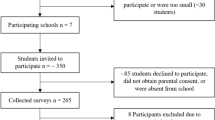Abstract
Objective To examine the prevalence of health risk-behaviors among American Indian/Alaska Native (AI/AN) youth in urban areas. Methods Data from the national Youth Risk Behavior Survey (YRBS) for the years 1997–2003 were used for the analyses (Urban sample = 52,364). The YRBS is a self-report questionnaire administered to a sample of 9th–12th grade students intended to monitor health risk-behaviors. “Urban” is defined as areas within a Metropolitan Statistical Area. Whites are used as the comparison group for the examination of AI/AN estimates. Results Urban AI/AN youth represented 1% of the urban sample (N = 513). The presence of a number of risk-behaviors were at least threefold higher in AI/AN compared to white youth in urban areas, including suicidal behaviors, feeling unsafe at school and needing medical treatment from a fight. Other factors were over twofold higher among AI/AN, including sexual behaviors, illegal drug use, violence at school, and experiences of rape, assault and pregnancy. Conclusions The higher prevalence of health risk-behaviors in urban AI/AN compared to white youth reflects a need for interventions focused on urban AI/AN youth.
Similar content being viewed by others
References
U.S. Census Bureau. Census 2000 summary file 2 (SF2), Matrix PCT2.
U.S. Census Bureau. Census 2000 American Indian and Alaska Native summary file, Matrices PCT3, PCT4.
Hobbs, F., & Stoops, N. (2002) U.S. Census Bureau, Demographic trends in the 20th Century, Census 2000 special reports, Series CENSR-4. Washington, DC: U.S. Government Printing Office.
Harris, K. M., Gordon-Larsen, P., Chantala, K., & Udry, J. R. (2006). Longitudinal trends in race/ethnic disparities in leading health indicators from adolescence to young adulthood. Archives of Pediatrics & Adolescent Medicine, 160, 74–81.
Blum, R. W., Harmon, B., Harris, L., Bergeisen, L., & Resnick, M. D. (1992). American Indian–Alaska Native youth health. JAMA, 267(12), 1637–1644.
U.S. Department of Health and Human Services, Indian Health Service. Available online: www.ihs.gov/FacilitiesServices/AreaOffices/AreaOffices_index.asp. Accessed 29 Nov 2007.
Brener, N. D., Kann, L., & Kinchen, S. A. (2004). Methodology of the youth risk behavior surveillance system. CDC recommendations and reports (September 24). MMWR, 53(RR12), 1–13.
U.S. Census Bureau. Cartographic boundary files. Geography Division, Cartographic Products Management Branch. http://www.census.gov/geo/www/cob/ma_metadata.html. Accessed 11 Oct 2005.
STATA Statistical Software for Professionals. http://www.stata.com/. Version 8.2.
U.S. Department of Health and Human Services. Office of Disease Prevention and Health Promotion, Healthy People 2010, Physical Activity. Available online: www.healthypeople.gov/Document/html/tracking/od22.htm#physactchild. Accessed 1/31/06.
Castor, M. L., Smyser, M. S., Taualii, M. M., Park, A. N., Lawson, S. A., & Forquera, R. A. (2006). A nationwide population-based study identifying health disparities between American Indians/Alaska Natives and the general populations living in select urban counties. American Journal of Public Health, 96(5).
Urban Indian Health Institute, Seattle Indian Health Board. (2007). Urban American Indian and Alaska Native youth: An analysis of select national data sources. Available online: www.uihi.org.
Henry-Tanner, L., & Tanner, C. (2005). Living like neighbors: Supporting the treaty rights and sovereignty of indigenous nations. Northwest Community Alliance.
Walters, K. L., & Simoni, J. M. (2002). Reconceptualizing native women’s health: an “indigenist” stress-coping model. American Journal of Public Health, 92(4), 520–524.
Pothoff, S. J., Bearinger, L. H., Skay, C. L., Cassuto, N., Blum, R. W., & Resnick, M. D. (1998). Dimensions of risk behaviors among American Indian youth. Archives of Pediatrics & Adolescent Medicine, 152, 157–163.
Freedenthal, S., & Stiffman, A. R. (2004). Suicidal behavior in urban American Indian adolescents: A comparison with reservation youth in a southwestern state. Suicide and Life-Threatening Behavior, 34(2), 160–171.
Bearinger, L. H., Pettingell, S., Resnick, M. D., Skay, C. L., Potthoff, S. J., & Eichhorn, J. (2005). Violence perpetration among urban American Indian youth: Can protection offset risk? Archives of Pediatrics & Adolescent Medicine, 159, 270–277.
Warnecke, R. B., Johnson, T. P., Chavez, N., Sudman, S., O’Rourke, D. P., Lacey, L., & Horm, J. (1997). Improving question wording in surveys of culturally diverse populations. Annals of Epidemiology, 7(5), 334–342.
Johnson, T. P., Cho, Y. I., Holbrook, A. L., O’Rourke, D., Warnecke, R. B., & Chavez, N. (2006). Cultural variability in the effects of question design features on respondent comprehension of health surveys. Annals of Epidemiology, 16(9), 661–668.
Montana Youth Risk Behavior Survey: American Indian students in urban schools. (2005). Montana Office of Public Instruction. Available online: www.opi.state.mt.us/pdf/YRBS/NARReport.pdf. Accessed 24 June 2007.
U.S. Census Bureau. Census 2000 Summary file 4 (SF4), Matrix PCT62.
Freeman, C., & Fox, M. (2005). U.S. Department of Education, Status and trends in the education of American Indians and Alaska Natives. National Center for Education Statistics, 108.
Bernard, B., & Marshall, K. (1997). Protecting adolescents from harm: Finding from the National Longitudinal Study on Adolescent Health Findings. JAMA, 278(10), 823–832.
U.S. Department of Health and Human Services, Indian Health Service, Urban Indian Health Program. Available online: www.ihs.gov/nonmedicalprograms/urban/urban_index. Accessed 13 June 2007.
Acknowledgements
The UIHI gratefully acknowledge the Public Health—Seattle & King County for their assistance in making this project possible. We would like to send a special thank you to Mike Smyser MPH and Amy Laurent MPH from the Epidemiology, Planning and Evaluation Unit for all their efforts and commitment to this project.
Author information
Authors and Affiliations
Corresponding author
Rights and permissions
About this article
Cite this article
Rutman, S., Park, A., Castor, M. et al. Urban American Indian and Alaska Native Youth: Youth Risk Behavior Survey 1997–2003. Matern Child Health J 12 (Suppl 1), 76–81 (2008). https://doi.org/10.1007/s10995-008-0351-3
Received:
Accepted:
Published:
Issue Date:
DOI: https://doi.org/10.1007/s10995-008-0351-3



